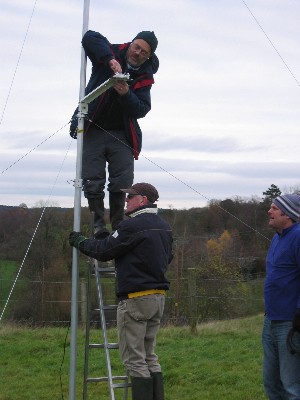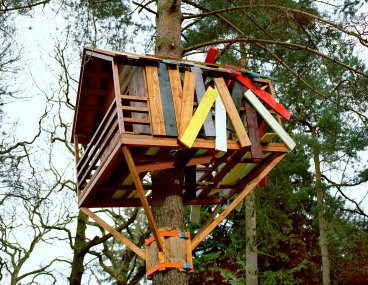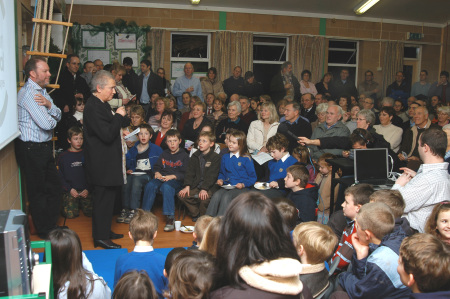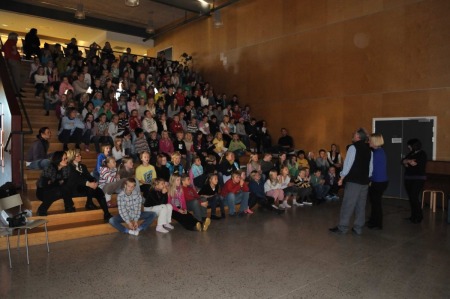"Growing up green" study findings by Rebecca Collins
 Saturday, August 22, 2020 at 9:44AM
Saturday, August 22, 2020 at 9:44AM Last year, Rebecca Collins of the University of Chester examined how the Going Carbon Neutral Project influenced young people and if their behaviours went beyond the village. Rebecca has prouced this short summary of her findings...
“I think the impact that it has on the young people in those towns you know, one to many and then one to many again if you can inspire a group of individuals who will become more involved in politics and move to another city and start to try and replicate those things and spreading it.” (Project Participant 4)
In 2018 I was awarded a Small Research Grant by the Royal Geographical Society (with the Institute of British Geographers) (RGS-IBG) to investigate the extent to which the individual and household behaviours associated with carbon neutral living, promoted through Ashton Hayes’s ‘Going Carbon Neutral’ (GCN) project, travelled beyond the village. Given my research interest in the ways that young people engage with climate change/sustainability initiatives, my project specifically explored whether young adults who had ‘grown up green’ in the village during Ashton’s push towards carbon neutrality were able to carry that ‘greening’ with them – both in terms of aspiration and practice – as they moved on from the village to form independent households elsewhere. Thanks to the generous support of Roy Alexander, Garry Charnock, Jane Colville, as well as members from the community energy company, village shop, pavilion and Women’s Institute, I was able to interview ten young adults who had grown up in Ashton about their experiences of ‘growing up green’ – and the opportunities and barriers they have encountered in their attempts to embed sustainability principles in their everyday lives since moving away.
This short piece summarises just some of the findings that will be going into one of the articles I’m producing based on this research. These findings are by no means exhaustive – it’s surprising how much information emerges from just ten conversations! – but I’ve focused on these as I think they may be of particular interest, specifically because of what they reveal about the importance of social relationships in promoting and embedding action around sustainable living. At the end I summarise some of the main challenges that my interviewees highlighted as inhibiting their ability to put some of their aspirations into practice. None of these will be a surprise – all of them reflect substantial, systemic issues, far beyond the change-driving capacity of a single village, and issues which are not limited to the UK. I mention them here, though, because I think it’s important to acknowledge that, whilst initiatives like AHGCN are not the silver bullet that can create large-scale change, they have enormous value in cultivating a shared social desire for that change. They also create a considerable amount of what social scientists call embodied knowledge – knowledge that becomes ingrained in our bodies and habits and dispositions – that can sit, semi-dormant, waiting for the opportunity to be called back into use.
KEY PROJECT FINDINGS: Social relationships for (or against?) sustainable living
1. Ebbing and flowing of engagement
There was no one ‘recipe’ for effective engagement of the young adults growing up in Ashton during the Going Carbon Neutral project. Their interest ebbed and flowed during adolescence. Specifically:
§ Those who were of primary school age when the project launched, and who attended the village school, strongly remembered the excitement of the project launch, describing this as having a significant and lasting impact on the importance they placed on environmental issues, even now as young adults. The ‘fanfare’ and media attention effectively underlined the significance of what GCN was seeking to achieve. Participants reported that this excitement helped sustain their interest in the topic over time, whereas they saw interest from peers outside the village or at other schools as more short-lived and superficial.
-
§ Participants reported a degree of wariness in talking much about environmental matters with their peers during secondary school. As one participant related,
“... when you get to high school [...] everyone has very different sort of priorities [...] trying to fit in and sort of shouting about how environmentally friendly you are isn’t probably the way you’re going to fit in. [...] All you want to do is make some friends and try and fit in and there’s lots of other things you’re going to worry about more than the environment when you’re 14 years old.”
Another participant reported being grateful that her teenage peers couldn’t see her carefully
sorting the recycling at home.
-
§ Despite these concerns about the negative judgement of peers during early adolescence, the
participants talked with great warmth and gratitude about the social relationships within the village, often with close family friends who were interested in and involved in GCN, which nurtured their interest during this period.
-
§ Upon reaching sixth-form/college age, it was once again deemed socially acceptable to discuss, and express care for, environmental issues. This was partly to do with a shift in the style of formal learning towards greater discussion and debate, and partly because of stronger individual senses of self, which tend to start to coalesce in the later teenage years.
This ebb and flow of engagement offers some useful signposts for anyone seeking to engage young people in environmental issues. Primary school seems to be a key time to light the touch paper of excitement, which, even taking into account an understandable disconnect during the early secondary school years, can be reignited in later adolescence when young adults actively seek to discuss and debate on their own terms.
2. What was learned, how, and from whom?
In most cases, participants reported an interest in environmental issues, and a degree of ‘good practice’ in terms of applying principles of sustainable living, already present within their family, either from parents or grandparents. Most also stated that they would have had a personal interest in the topic, even if AHGCN hadn’t taken place. This made it difficult for all participants to distinguish between which habits were personal or family norms that preceded GCN and which emerged because of it. However, participants observed that GCN produced some direct benefits in terms of their own learning:
-
§ It provided opportunities to get directly involved in projects related to GCN, which meant that interest in climate change and sustainability became more than intellectual interests. These helped embed learning from the project in participants’ memories – even if it wasn’t yet possible for them to put them into practice in their current day-to-day lives.
-
§ These opportunities were facilitated through the close social relations that already existed in the village, and which were fundamental to the development of GCN. Although there are challenges as well as benefits to the existence of close, established ‘in groups’ in a community, the participants regularly made reference to appreciating learning from and with community members in the course of these projects. One described this context as a “safe space” in which to be interested.
-
§ The fact that the participants were often already firmly placed in these social networks, e.g. through helping out at the village shop, helped them build relationships across generational boundaries, allowing them to feel comfortable asking questions about GCN and volunteering for projects, making themselves part of the activity, as this had already been modelled through other aspects of community life. (It shouldn’t be taken for granted that young adults always have this ‘place’ within local community networks!)
§ GCN also provided valuable experience for participants in organising events, communicating with different types of people in different formats, and understanding the enormous challenge of mobilising a whole community. Several participants noted that the opportunity to develop these skills – framed by one in terms of ‘CV building’ – were just as attractive as furthering their environmental interest, if not more so.
In summary, although there were discussions and habits within participants’ own families that, to an extent, may have catalysed their environmental interests and habits, it was the cross-generational conversations and opportunities within the Going Carbon Neutral project that were most important to the lasting learning that they have taken with them as they have moved on from the village. This underlines the importance of facilitating mechanisms to enable interactions across generations and family groups, in order to create opportunities for young people to get involved, including during the socially tricky secondary school years.
3. Where next for those who have ‘grown up green’?
All of my interviewees were either current university students, or university graduates now working in graduate-level employment, ranging from teaching to management consultancy. (I sought a broader sample, but had no success recruiting volunteers who were not university educated.) This means that these young adults likely have access to a range of resources – primarily economic and social – that many of their peers do not. (There is a broader point of discussion here related to who from the village was engaged with GCN, who wasn’t, and why – but I’m afraid that’s far beyond the scope of this post!) There is a risk, as a result, that the knowledge that emerges from projects like GCN becomes siloed within social groups that possess the resources to put them into practice - as well as access the opportunity to gain that knowledge in the first place.
Having said that, the current economic context certainly does not give even university educated, socially connected young adults an easy time. This was true pre-covid and the reality has only become harsher in recent months. Participants in my project made reference to a number of challenges that inhibited their ability to ‘do more’ to live sustainably in the present – and which reflect the very real challenges faced by young adults across the UK (and beyond): the precariousness of their employment or housing; the cost of living (particularly rent); and the lack of sufficiently enabling infrastructures (particularly in relation to transportation). For all of them – as for most of us – money remained the primary deciding factor in the vast majority of their day-to-day consumption decisions. Intentions to draw on their learning from GCN when personal and economic circumstances permitted were common. Interestingly, regardless of a participants’ age (23 or 33, for example), everyone seemed to anticipate that a point at which they would be able to start spending more on ‘lower impact’ consumption (whether food, energy, or something else) was 2-3 years away. Was this just a conveniently middle-distance time horizon? Perhaps. Maybe I’ll have to do some follow-up interviews in 2022 and find out.
Postscript
There is so much more to say than I have been able to include here. I’ve far exceeded the ‘600-ish words’ I originally agreed to write! As articles based on this research are published, I will share links to them here. (Note that academic publishing timeframes mean this is likely to be a couple of years off!) If you would like to know more about this project in a somewhat shorter timeframe, please feel free to drop an email to rebecca.collins@chester.ac.uk









